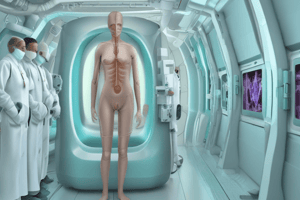Podcast
Questions and Answers
What is the primary use of the Model 44-2 gamma scintillator?
What is the primary use of the Model 44-2 gamma scintillator?
- Monitoring environmental temperature
- Measuring magnetic fields
- Detecting low levels of gamma radiation (correct)
- Assessing sound levels
What is the thickness of the aluminum housing for the Model 44-2?
What is the thickness of the aluminum housing for the Model 44-2?
- 0.09 cm
- 0.157 cm (correct)
- 0.075 cm
- 0.2 cm
Which range of energy levels does the Model 44-2 detect?
Which range of energy levels does the Model 44-2 detect?
- 15 keV–2.0 MeV
- 20 keV–1.5 MeV (correct)
- 10 keV–1.0 MeV
- 5 keV–1.8 MeV
What is the detector's response at 100 keV compared to 137Cs?
What is the detector's response at 100 keV compared to 137Cs?
How should the detector be connected to other instruments for optimal operation?
How should the detector be connected to other instruments for optimal operation?
For what type of analysis can the Model 44-2 be used in conjunction with an analyzer?
For what type of analysis can the Model 44-2 be used in conjunction with an analyzer?
What component is coupled to the NaI crystal in the Model 44-2?
What component is coupled to the NaI crystal in the Model 44-2?
Which of the following specifications limits the linear range for the Model 44-2 Gamma Scintillator?
Which of the following specifications limits the linear range for the Model 44-2 Gamma Scintillator?
What is the typical sensitivity of the Model 44-2 Gamma Scintillator for 137 Cs gamma?
What is the typical sensitivity of the Model 44-2 Gamma Scintillator for 137 Cs gamma?
What is the operating voltage range for the Model 44-2 Gamma Scintillator?
What is the operating voltage range for the Model 44-2 Gamma Scintillator?
What is the maximum temperature range for which the Model 44-2 Gamma Scintillator is certified?
What is the maximum temperature range for which the Model 44-2 Gamma Scintillator is certified?
What approach should be taken when connecting the detector to the instrument?
What approach should be taken when connecting the detector to the instrument?
What background count rate is typically recorded by the Model 44-2 Gamma Scintillator?
What background count rate is typically recorded by the Model 44-2 Gamma Scintillator?
What is the primary construction material of the Model 44-2 Gamma Scintillator housing?
What is the primary construction material of the Model 44-2 Gamma Scintillator housing?
What is the typical background reading range for the detector?
What is the typical background reading range for the detector?
What should the detector indicate when exposed to a check source?
What should the detector indicate when exposed to a check source?
What environmental condition is NOT suitable for using the detector?
What environmental condition is NOT suitable for using the detector?
Which cleaning method is acceptable for the detector?
Which cleaning method is acceptable for the detector?
What is a requirement regarding the pollution degree for the detector?
What is a requirement regarding the pollution degree for the detector?
When cleaning the detector, what should be done first?
When cleaning the detector, what should be done first?
What is the maximum temperature range for the normal operation of the detector?
What is the maximum temperature range for the normal operation of the detector?
What might indicate a malfunction in the detector?
What might indicate a malfunction in the detector?
Flashcards are hidden until you start studying
Study Notes
Ludlum Model 44-2 Gamma Scintillator Overview
- Designed for detecting low levels of gamma radiation in the range of 20 keV–1.5 MeV.
- Features a sodium iodide (NaI) crystal measuring 2.54 x 2.54 cm (1 x 1 in.) coupled to a photomultiplier tube.
- Enclosed in 0.157 cm (0.062 in.) thick aluminum housing with a front window thickness of 2.3 mm (0.09 in.).
- Energy response varies, with a 10x over-response in the 100 keV range and a 0.5x under-response above 1 MeV, normalized to 137Cs.
- Compatible with Ludlum instruments providing 500–1200 volts, with a typical input sensitivity of 10 mV or higher.
Warranty Information
- Warranty covers defects in workmanship, material, and design for 12 months from delivery.
- Calibration is warranted within specified accuracy limits at shipment; excludes broken photomultiplier and scintillation tubes due to misuse.
- Remedies for performance issues include repair or replacement; no liability for incidental or consequential damages.
Specifications
- Sensitivity: Typically 175 cpm per µR/hr for 137Cs gamma.
- Dead Time: Approximately 10 µs, limiting linear range to 5 mR/hr (50 µSv/h) without correction.
- Energy dependence affects efficiency (4 π): 7% for I, 10% for 57Co, 3% for 137Cs and 60Co.
- Operating Conditions: Suitable for temperatures -15 to 50 °C (5 to 122 °F); can be certified from -40 to 65 °C (-40 to 150 °F).
- Weight: 0.5 kg (1 lb) and size is 5.1 x 18.5 cm (2 x 7.3 in.).
Operating Procedures
- Connect detector to an instrument securely by twisting connectors clockwise.
- High voltage settings should match the detector specifications.
- Verify background readings (1.4-2.6 kcpm or 8-15 µR/hr) and check against a known source for accuracy within 20%.
Safety Considerations
- Designed for indoor or outdoor use in dry environments, without maximum altitude restrictions.
- Maintenance of a maximum relative humidity of 95% (non-condensing) is crucial.
- Cleaning should only involve wiping with a damp cloth using water; immersion in liquids is not permitted.
Parts List and Assembly
- Key components include the detector body, end cap, NaI crystal, tube socket assembly, and various electronic parts.
- The detector is completely assembled as Model 44-2 and includes detailed part numbers for replacement or repair.
- Proper packing materials are necessary for returns to ensure equipment safety during shipment.
Additional Notes
- No consumable materials are included with the detector; appropriate handling is essential to maintain functionality.
- An Instrument Return Form must accompany any returns, available from the Ludlum website under support sections.
Studying That Suits You
Use AI to generate personalized quizzes and flashcards to suit your learning preferences.




